Related Research Articles

Sambandar, also referred to as Tirugnana Sambandar, Tirujnanasambanda, Campantar or Jñāṉacampantar, was a Shaiva poet-saint of Tamil Nadu who lived sometime in the 7th century CE. He was a child prodigy who lived just 16 years. According to the Tamil Shaiva tradition, he composed an oeuvre of 16,000 hymns in complex meters, of which 383 (384) hymns with 4,181 stanzas have survived. These narrate an intense loving devotion (bhakti) to the Hindu god Shiva. The surviving compositions of Sambandar are preserved in the first three volumes of the Tirumurai, and provide a part of the philosophical foundation of Shaiva Siddhanta.
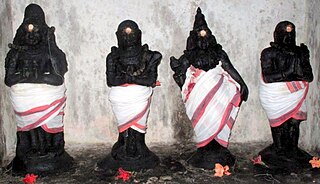
Thirumurai is a twelve-volume compendium of songs or hymns in praise of Shiva in the Tamil language from the 6th to the 11th century CE by various poets in Tamil Nadu. Nambiyandar Nambi compiled the first seven volumes by Appar, Sampandhar and Sundarar as Tevaram during the 12th century. During the course of time, a strong necessity was felt by scholars to compile Saiva literature to accommodate other works. Tiruvasakam and Tirukovayar by Manickavasagar are included as the eighth, nine parts are compiled as the ninth Tirumurai out of which most are unknown, and the tenth as Tirumandiram by Tirumular, the famous Siddhar. The eleventh is compiled by Karaikal Ammaiyar, Cheraman Perumal and others. The contemporary Chola king was impressed by the work of Nambi and included Nambi's work in the eleventh Tirumurai. Sekkizhar's Periya Puranam, composed a century later, contains the life depiction of all the 63 Nayanmars. The response for the work was so tremendous among Saiva scholars and Kulothunga Chola II that it was included as the 12th Tirumurai. Tirumurai along with Vedas and Saiva agamas form the basis of Saiva Siddantha philosophy in South India and Sri Lanka.

The Periya purāṇam, that is, the great purana or epic, sometimes called Tiruttontarpuranam, is a Tamil poetic account depicting the lives of the sixty-three Nayanars, the canonical poets of Tamil Shaivism. It was compiled during the 12th century by Sekkizhar. It provides evidence of trade with West Asia The Periya Puranam is part of the corpus of Shaiva canonical works.
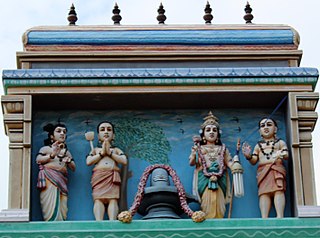
Sundarar, also referred to as Chuntarar, Chuntaramurtti, Nampi Aruran or Tampiran Tolan, was an eighth-century poet-saint of Tamil Shaiva Siddhanta tradition of Hinduism. He is among the Tevaram trio, and one of the most prominent Nayanars, the Shaiva bhakti (devotional) poets of Tamil Nadu.

The Thevaram, also spelled Tevaram, denotes the first seven volumes of the twelve-volume collection Tirumurai, a Śaiva narrative of epic and puranic heroes, as well as a hagiographic account of early Saiva saints set in devotional poetry. The Thevaram volumes contain the works of the three most prominent Saiva Tamil poets of the 7th and 8th centuries: Sambandar, Appar, and Sundarar. The three poets were not only involved in portraying their personal devotion to Shiva, but also engaged a community of believers through their songs. Their work is an important source for understanding the Śaiva Bhakti movement in the early medieval South India.
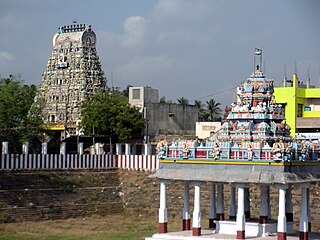
Thyagaraja Temple is a Hindu temple dedicated to Hindu god Shiva. It is located in Tiruvottiyur in the northern part of Chennai, Tamil Nadu, India. The temple is revered by the Tevaram hymns of Saiva nayanars, the 7th century Tamil saint poets and classified as Paadal Petra Sthalam. All the Three of Thevaram Moovar has rendered Thevaram songs in this temple. The temple is closely associated with the saint poet Sundarar and Pattinathar. The temple has been in vogue from the Pallava times of the 7th century and widely expanded by Chola kings during the 11th century. The temple has a seven tiered gateway tower, a tank, with the overall temple area covering 1 acre. The temple is administered by the Hindu Religious and Endowment Board of the Government of Tamil Nadu. The temple draws parallel with the Thygaraja temple in Tiruvarur as both the temples were expanded by Rajendra Chola I and both have the same dance poses of Shiva. The temple is one of the 51 Sakthi Peetams in the country.
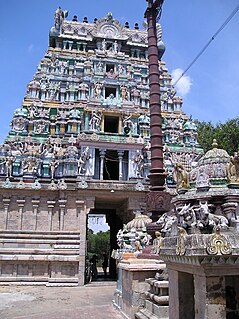
Kalyanasundaresar Temple, Nallur or Thirunallur is a Hindu temple dedicated to the deity Shiva, located in Nallur, in the outskirts of Kumbakonam in Tamil Nadu, India. Shiva is worshiped as Kalyansundaresar and is represented by the lingam. His consort Parvati is depicted as Girisundari. The presiding deity is revered in the 7th century Tamil Saiva canonical work, the Tevaram, written by Tamil saint poets known as the nayanars and classified as Paadal Petra Sthalam. The legend of the temple is associated with sage Agastya and Amaraneethi Nayanar, one of the 63 nayanars, the Tamil Saiva saints. The lingam in the temple is believed to change colours five times during the daytime.

Vedaranyeswarar Temple is a Hindu temple dedicated to the god Shiva, located in the town of Vedaranyam in Tamil Nadu, India. Vedaranyeswarar is revered in the 7th century Tamil Shaiva canonical work, the Tevaram, written by Tamil saint poets known as the Nayanars and classified as Paadal Petra Sthalam. It is the only temple to have found mention in all the seven Thirumurais. The temple is famed for the legend between the saints Appar and Sambandar when the former sang to open the door while the latter sang to close the door.
Muruga Nayanar or Muruka Nayanar is the 15th Nayanar saint. Traditional hagiographies like Periya Puranam and Thiruthondar Thogai describe him as a great devotee of the Hindu god Shiva. He is described to have lived an ascetic life, filled with austerity and selfless devotion to Shiva, spending his time in collecting flowers from woodlands and decorating the Shiva Lingam with garlands and coronets.
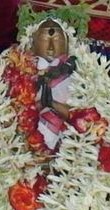
Apputhi Adigal, also spelt as Apputhi Adikal, Atputhi Adigal, Apputi Adigal, Appoodi Adikal, Appoothi Adikal and Appudhi Adigal and known as Appuddi Nayanar, was a Nayanar saint, venerated in the Hindu sect of Shaivism. He is generally counted as the twenty-fifth in the list of 63 Nayanars. He is described as a contemporary of Appar or Thirunavukkarasar, one of the most prominent Nayanars.
Idangazhi (Idangali), also known as Idangazhi Nayanar, Idangaliyar (Idankaliyar) was a Nayanar saint, venerated in the Hindu sect of Shaivism. He is generally counted as the fifty-fourth in the list of 63 Nayanars. He was an Irukku Velir chieftain, who is described to not only have pardoned a devotee of the god Shiva, who stole from the royal granaries, but also distributed rice to devotees of Shiva.
Satti Nayanar, also known as Satti (Sathi), Sathiyar, Shakti Nayanar, Shakti, Shaktiyar (Saktiyar), Sattiyandar and Thiru-Saththi Nayanar, is a Nayanar saint, venerated in the Hindu sect of Shaivism. He is generally counted as the 45th in the list of 63 Nayanars. Satti Nayanar is described to cut off the tongue of whoever talked ill of his patron god Shiva or Shiva's devotees.
Kungiliya Kalaya Nayanar, also known as Kungiliya Kalaya, Kalayar, Kunguliya and Kalaya Nayanar, is a Nayanar saint, venerated in the Hindu sect of Shaivism. He is generally counted as the eleventh in the list of 63 Nayanars.

Nami Nandi Adigal, also spelt as Naminandi adigal, Naminandi adikal and Naminanti Atikal, and also known as Naminandi and Naminandhi, is a Nayanar saint, venerated in the Hindu sect of Shaivism. He is generally counted as the 27th in the list of 63 Nayanars.
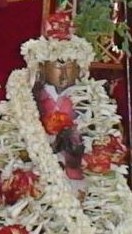
Somasi Mara Nayanar, also known as Somasi Maranar, Somasi Marar, Somasimarar and Somasira Nayanar, is a Nayanar saint, venerated in the Hindu sect of Shaivism. He is generally counted as the thirty-third in the list of 63 Nayanars. He is also called Marar, Maran and Mara Nayanar, names he shares with Ilayankudi Mara Nayanar. The two Nayanars are generally differentiated by the prefixes "Somasi" and "Ilayankudi". He was a contemporary and devotee of Sundarar.
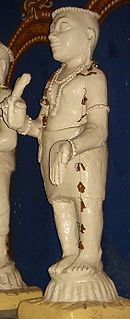
Eripatha Nayanar, also known as Eripathar, Eripatar, Eribattar, Eripattan', Eripaththa Nayanar and Eripattha Nayanar, is Nayanar saint, venerated in the Hindu sect of Shaivism. He is generally counted as the eighth in the list of 63 Nayanars.
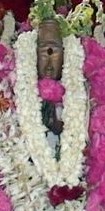
Pugal Chola, also known as Pukal Chola, Pukazhchozha Nayanar, Pugazh, Pukazhcchozhar, Pukal Cholan and Pugal Chola Nayanar, is described as a Chola ruler and was a Nayanar saint, venerated in Shaivism, one of the main sects of Hindu. He is generally counted as the eighth in the list of 63 Nayanars.
Sirappuli Nayanar, also known as Sirappuli, Sirapuli Nayanar, Sirappuliyar (Chirappuliyar), was a Nayanar saint, venerated in the Hindu sect of Shaivism. He is generally counted as the thirty-fifth in the list of 63 Nayanars. Sirappuli Nayanar is described to have served the devotees of the god Shiva and worshipped the god with various ritual practices.
Kutruva Nayanar, also known as Kootruva , Kutruva, Kutruvar, Kootruvar, Kurruva Nayanar, Kurruvar, Kurruvan, Kutruvanar, Kurrrruvar, Kalappallan and Kalappalar, was a chieftain of Kalandai and a Nayanar saint, venerated in the Hindu sect of Shaivism. He is generally counted as the 39th in the list of 63 Nayanars. Kutruva is often described as a Jain, who became a devotee of Shiva, the patron god of Shaivism.
Srimoolanathar Temple is a Hindu temple dedicated to the deity Shiva, located at Keezhaiththanjavur in Nagapattinam district, Tamil Nadu, India.
References
- 1 2 dhaNdiyadigaL nAyanAr
- 1 2 3 Swami Sivananda (1962). SIXTY-THREE NAYANAR SAINTS. A DIVINE LIFE SOCIETY PUBLICATION.
- 1 2 3 Dehejia, Vidya (1988). Slaves of the Lord- Path of the Tamil Saints. Munshirm Manoharlal Pub Pvt Ltd. pp. 27, 158. ISBN 9788121500449.
- 1 2 P. V. Jagadisa Ayyar (1993) [1982]. South Indian Shrines: Illustrated. Asian Educational Services. p. 381.